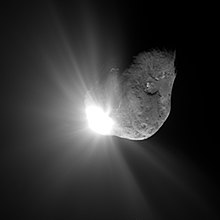Wikipedia:Featured picture candidates/Deep Impact HRI..jpeg
Deep Impact Probe Collision[edit]

This is an image of a high velocity copper impactor striking the surface of comet Tempel 1 creating drastic brightening that lasted for hours afterward. Created by the Deep Impact space mission on July 4th., it is perhaps the most striking scientific image of 2005. --Deglr6328 01:35, 30 December 2005 (UTC)
- Nominate and support. - Deglr6328 01:35, 30 December 2005 (UTC)
- Support good image of unusual occurance --rogerd 22:29, 31 December 2005 (UTC)
- Comment What causes the ripples that apear in the left? Debivort 02:14, 1 January 2006 (UTC)
- When DI flew, it carried (I think) one of the largest telescopes ever on a deep space mission. In designing the telescope, the engineers basically have to guess at how the composite materials that make up the optics design will behave in 0g and with highly varying temperatures of space. They guessed a little wrong and the optical path that light took through the telescope was either a little longer or shorter (can't remember) than anticipated. This can be corrected for however, using a mathematical transformation on the resultant blurry images returned in order to recover most of the lost resolution. This is called optical deconvolution and though it worked very well in this case it is not perfect and it causes some artefacts. I strongly suspect that is the reason behind the fringing effects seen in the image. The small dark rings seen in the lower part of the plume are from dust on the telescope's lenses. --Deglr6328 06:31, 1 January 2006 (UTC)
- Support. Striking image! (excuse the pun). --Janke | Talk 15:17, 1 January 2006 (UTC)
- Obvious supportCirceus 19:51, 1 January 2006 (UTC)
- Support. — 0918BRIAN • 2006-01-2 06:39
- Support, though I wonder if we can get a bigger version. Flcelloguy (A note?) 02:20, 3 January 2006 (UTC)
- Perhaps later when the full dataset is released to the NASA PDS. The benefit will be negligible though. Thee CCD on DI is a 1024 x 1024 Split Frame Transfer type and this image is already 900 X 900.--Deglr6328 07:49, 3 January 2006 (UTC)
- Support. Stunning image. enochlau (talk) 11:08, 6 January 2006 (UTC)
- Support. A marvelous image. Greatigers 02:26, 10 January 2006 (UTC)
- Support DaGizzaChat (c) 04:34, 12 January 2006 (UTC)
- support Amazing image that i am convinced will draw a lot of people toward it --Ali K 15:01, 12 January 2006 (UTC)
Promoted Image:Deep_Impact_HRI.jpeg Raven4x4x 05:58, 13 January 2006 (UTC)
